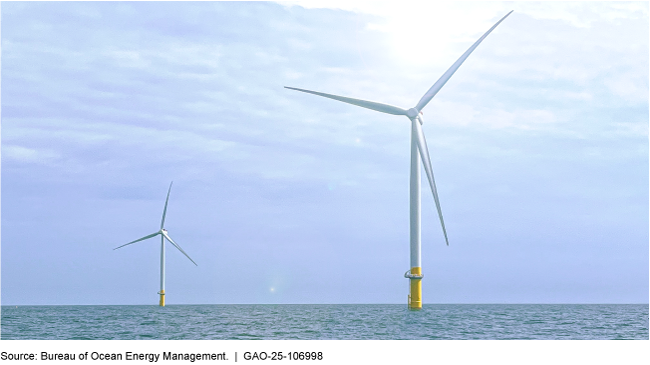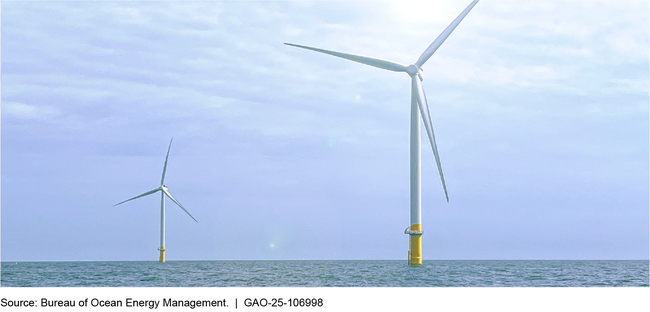Offshore Wind Energy: Actions Needed to Address Gaps in Interior's Oversight of Development
Fast Facts
Offshore wind energy is a growing U.S. source of renewable energy. It could also affect public health, tribal resources, and more—but the extent of any potential effects is uncertain.
The Department of the Interior and other federal agencies oversee offshore wind energy development. They are supposed to work with Tribes, fisheries, and other groups that could be affected. But their engagement with these groups isn't consistent. Also, when the agencies get feedback from affected groups, they have inconsistently considered or addressed their concerns.
Our recommendations address these and other issues.

Highlights
What GAO Found
Offshore wind energy development has various potential positive and negative impacts in several areas. These include climate and public health, marine life and ecosystems, fishing industry, economic and community, tribal resources, defense and radar systems, and maritime navigation and safety impacts. However, because it is early in U.S. deployment of commercial offshore wind projects, the extent of some impacts is unknown. Moreover, uncertainty exists about long-term and cumulative effects, and the extent of impacts will vary depending on the location, size, and type of offshore wind infrastructure. Because of the lack of definitive research related to some impacts, GAO convened a panel of 23 experts with assistance from the National Academies of Sciences, Engineering, and Medicine (National Academies) to identify and evaluate what is known about the potential impacts of offshore wind development.
Among such impacts, development and operation of offshore wind energy facilities could affect marine life and ecosystems, including through acoustic disturbance and changes to marine habitats. Wind development could bring jobs and investment to communities. At the same time, it could disrupt commercial fishing to varying degrees. Turbines could also affect radar system performance, alter search and rescue methods, and alter historic and cultural landscapes.
Areas of Potential Offshore Wind Energy Impacts

The Department of the Interior's Bureau of Ocean Energy Management (BOEM) and the Bureau of Safety and Environmental Enforcement (BSEE) oversee offshore wind energy development. This is conducted through a multi-year permitting process that includes coordination with other agencies and stakeholders to identify and mitigate potential impacts.
However, Tribes have raised concerns regarding BOEM's consultation with them. During initial planning of wind energy areas and when establishing wind lease areas, BOEM has taken steps to incorporate tribal input but has not consistently engaged in meaningful consultation with Tribes. BOEM documents indicate that it received tribal officials' concerns but do not consistently demonstrate efforts to consider or address these concerns. BOEM officials acknowledged room for improvement and released a strategy for tribal engagement in December 2024. However, its implementation plan remains unclear. Clearly demonstrating and routinely reporting on its progress would help ensure that BOEM is adequately considering tribal concerns and building trust with Tribes. Also, nearly all tribal officials that GAO interviewed said that they do not have sufficient capacity to adequately review documents or meaningfully consult with government officials and developers. Agency officials stated that consultation has been hindered by limitations in BOEM's statutory authority to provide support for tribal capacity building. Without a change to BOEM's authority, tribal input and Indigenous knowledge may not be sufficiently incorporated into decisions.
Coastal Virginia Offshore Wind Pilot Project

BOEM has taken steps to inform fisheries stakeholders about its process and efforts to incorporate their input when establishing a lease area for offshore wind projects. However, stakeholders remain concerned that BOEM has not adequately considered or addressed the concerns of the commercial fishing industry and fisheries management councils at that stage of the permitting process. BOEM considers competing uses of the areas under consideration for development, including commercial fishing.
While BOEM has met with fishing industry representatives during the process, fishery stakeholders said they viewed BOEM's responses to input as unclear or insufficient. Moreover, it is not clear how BOEM ensures that these stakeholders are consistently included in the process and informed of BOEM's efforts to incorporate input from the industry when establishing lease areas. As a result, development of offshore wind energy could proceed without BOEM showing how it fully considers impacts to fisheries and how it will ensure developers address impacts to the fishing industry.
In addition, opportunities exist for BOEM and BSEE to improve enforcement of lessees' community engagement. Lessees are to create community communication and engagement plans, but BOEM and BSEE have not established guidance for these plans. BOEM and BSEE also do not have a plan to monitor implementation and have not clarified their roles and responsibilities for monitoring implementation and enforcement. Without doing so, the agencies cannot ensure that they are fulfilling their oversight responsibilities or that lessees are effectively engaging with—and mitigating impacts to—affected communities.
Finally, BOEM and BSEE have not taken steps to ensure that they have the resources in place for effective oversight of offshore wind development. Specifically, neither agency has a physical presence in the North Atlantic region where offshore wind construction is underway. BOEM and BSEE officials stated that they are building capacity to oversee development. However, neither agency has taken the necessary steps to establish a physical office for that region, as they have done in the Pacific and the area formerly known as the Gulf of Mexico. Doing so will help ensure that BOEM and BSEE have the resources in place to oversee development in the region and effectively address potential impacts, engage with stakeholders, and oversee implementation of lease requirements.
Why GAO Did This Study
Offshore wind energy development in the U.S. is expanding. There are active wind farms and construction in the Atlantic and planned development off the Pacific coast and in the Gulf of Mexico. BOEM and BSEE are responsible for permitting and oversight of offshore wind projects. Numerous other federal agencies provide input throughout the process. As of January 2025, BOEM had granted 39 offshore wind leases to commercial developers, but on January 20, 2025, the President issued a memorandum that, among other things, prohibits agencies from new leasing, permits, or approvals for offshore wind projects pending a review of federal wind leasing and permitting practices. As the pace of offshore wind development has accelerated, state and local communities, Tribes, and non-government entities could experience the potential effects of offshore wind development.
GAO was asked to review offshore wind development in federal waters. This report examines (1) what is known about the potential impacts of offshore wind energy development, and (2) what mechanisms BOEM, in coordination with other agencies, has in place to oversee offshore wind energy development and to what extent they address potential impacts.
To examine potential impacts, GAO contracted with the National Academies to identify a panel of 23 experts to include diverse participant backgrounds and cover a range of potential impact categories. These include impacts to emissions, marine life and ecosystems, and maritime navigation and safety. Information obtained through expert interviews formed the basis of GAO's findings on the potential impacts of offshore wind energy development.
GAO reviewed agency documentation related to federal management of potential offshore wind development impacts from lead agencies BOEM and BSEE, as well as coordinating agencies. These included project documents, memorandums of understanding between BOEM and federal partners, and studies. In addition, GAO reviewed studies and published research findings identified through a literature search, as well as prior GAO work, including a July 2024 Technology Assessment on approaches to address environmental effects of wind energy (GAO-24-106687).
To gather perspectives on potential impacts and federal oversight, GAO interviewed representatives from 22 Tribes and tribal organizations and multiple stakeholders from states, research institutes, fisheries, and industry, among others. GAO also interviewed officials from lead and coordinating agencies about potential impacts and their role in overseeing the offshore wind development and leasing process. To further examine mitigation of offshore wind impacts and discuss BOEM and BSEE oversight, GAO conducted two site visits to offshore projects with ongoing construction and operations activities.
Recommendations
GAO recommends that Congress consider amending language in legislation to address BOEM's limitations to providing adequate support for tribal capacity-building.
GAO is also making five recommendations to BOEM and BSEE, including that they address gaps in oversight related to (1) tribal consultation and incorporation of Indigenous knowledge; (2) consideration of input from the fishing industry; (3) guidance for communication and engagement plans; and (4) resources for oversight in the North Atlantic region. Interior agreed with all five recommendations.
Matter for Congressional Consideration
| Matter | Status | Comments |
|---|---|---|
| Congress should consider amending language in legislation to address limitations in BOEM's authority to enable it to provide adequate support for capacity building for Tribes and tribal organizations that provide Indigenous expertise to the offshore wind leasing process. (Matter for Consideration 1) | When we confirm what actions the agency has taken in response to this recommendation, we will provide updated information. |
Recommendations for Executive Action
| Agency Affected | Recommendation | Status |
|---|---|---|
| Department of the Interior | The BOEM Director should take steps to address gaps in its approach to tribal consultation, including clearly demonstrating and routinely reporting on its progress. This should include ensuring that annual tribal consultation reports clearly document decisions regarding tribal implications and preparing and submitting to Tribes a record of consultation that describes input and how it was addressed, as well as the reasoning for any instances in which input was not incorporated. (Recommendation 1) |
When we confirm what actions the agency has taken in response to this recommendation, we will provide updated information.
|
| Department of the Interior | The BOEM Director should take steps to ensure that it adequately demonstrates and publicly reports its consideration of fishing industry input. (Recommendation 2) |
When we confirm what actions the agency has taken in response to this recommendation, we will provide updated information.
|
| Department of the Interior | The BOEM and BSEE Directors should establish guidance for lessees with respect to lessees' communication and engagement plans, clearly define the agencies' respective roles and responsibilities, and develop a plan to monitor implementation of these plans. (Recommendation 3) |
When we confirm what actions the agency has taken in response to this recommendation, we will provide updated information.
|
| Department of the Interior | The BOEM and BSEE Directors should take steps to ensure that they have sufficient resources in place to oversee offshore wind energy development, including by establishing a physical office to oversee development in the North Atlantic region. (Recommendation 4) |
When we confirm what actions the agency has taken in response to this recommendation, we will provide updated information.
|
| Department of the Interior | The BOEM Director should develop guidance and specific requirements for lessees' data collection and sharing across offshore wind energy projects. (Recommendation 5) |
When we confirm what actions the agency has taken in response to this recommendation, we will provide updated information.
|
